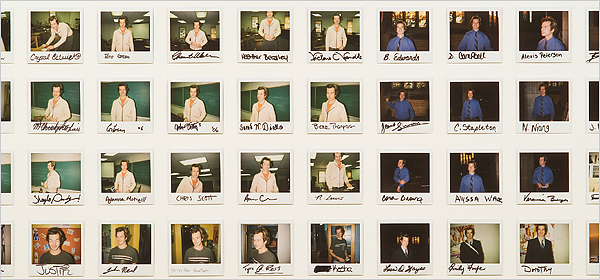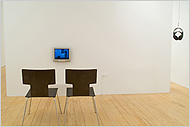| Want to send this page or a link to a friend? Click on mail at the top of this window. |
| Posted February 5, 2007 |
 |
|
Photograps courtesey of the artist and Oliver Kamm/5BE Gallery, New York |
|
LAST CHANCE |
|
| To Explore Race, Sometimes You Focus on the Explorer |
“FOR WHITES ONLY” is the title Joe Ovelman gave his solo show at the Oliver Kamm/5BE Gallery. So you know right away that he’s playing with race, which means that he’s playing with fire. The show is in two sections, and the first, a project titled “Rosa Parks 381,” is straightforward enough.
HOLLAND COTTER |
||
_______ |
||
|
Working at St. Philip’s Church in Harlem last fall, Mr. Ovelman issued a communitywide call for 381 volunteers to sit for Polaroid portraits; 381 is the number of days the 1955 Montgomery, Ala., bus boycott lasted. The only stipulation was that the sitters considered themselves to be African-American.
Mr. Ovelman, who identifies himself as white, took a picture of everyone who showed up, signed the works and gave them to the sitters. In return, he asked each sitter to take his picture, sign it and let him keep it. The portraits of Mr. Ovelman, all signed by the different volunteers, fill a gallery wall.
The gift-giving nature of the exchange feels nice and pokes gently at art world economics. Mr. Ovelman is the subject of the portraits here, but they are all by nonartists. The photographs he took, to which his artist status presumably gives sales value, are floating out in some other world, maybe valued or maybe not.
Questions arise when a white artist tries to define and commodify “blackness,” directly or indirectly. Such questions certainly come up here, yet they are nothing compared with those provoked by the show’s second half, installed in the back gallery.
On one wall hang seven tiny gold-wire images — about the size of earrings — depicting lynched bodies. Across the room are 12 hand-written examples of obscene racial slurs, which Mr. Ovelman says he overheard and copied down verbatim. A CD player holds 24 songs that all use a racial epithet that is now in popular circulation, but is still incendiary, depending on how and by whom it is spoken. Finally, there is a video of a young, nude African-Brazilian man alternately standing, sitting and pacing alone in a room. The video is hours long.
 |
|
Racism is the theme; time is the connection. The songs on the CD correspond to the number of hours in a day; the lynched figures, to the days in a week; the drawings, to the months in a year. The unedited video, filmed in a former slave-trading port in Brazil, is the length of an average work day (and, not coincidentally, of Andy Warhol’s “Empire”). And the man filmed is, indeed, working: Mr. Ovelman hired him to stay in front of the stationary camera for an unbroken eight-hour stretch.
The show, confrontational and affrontive, asks many questions and raises many problems. Would it feel less offensive, easier to “read,” if the artist were black, not white? That Mr. Ovelman is white, of course, is the point: a white artist making jewelry about lynchings in a white-run gallery, in a predominantly white art neighborhood, in a city largely run by whites.
But must such a white artist inevitably be viewed as acting opportunistically, in bad faith? A quote from James Baldwin appears on the gallery wall: “I’ll be black for as long as you tell me that you are white.” Is Mr. Ovelman trying to overload these distinctions with so much negative energy that they short-circuit?
Interestingly, the show, which continues through next Saturday, has attracted scant notice and generated little heat. Has a quarter-century of now unfashionable identity politics blunted rather than sharpened debate? Has thinking about race genuinely changed? Or has political apathy simply grown?
And, finally, within an insulated art world where art itself has become so closely identified with the retail market — just more expensive stuff, in another shop — does no one hear or care what art says?
“For Whites Only” continues through next Saturday at Oliver Kamm/5BE Gallery, 621 West 27th Street, Chelsea; (212) 255-0979.
Copyright 2007 The New York Times Company. Reprinted from The New York Times, TheArts, of Saturday, February 3, 2007.
| Wehaitians.com, the scholarly journal of democracy and human rights |
| More from wehaitians.com |